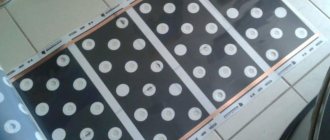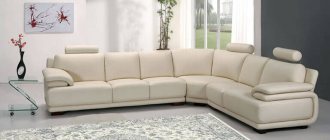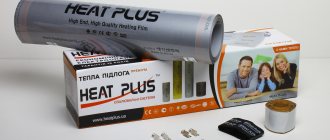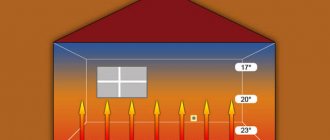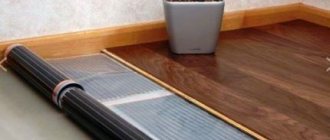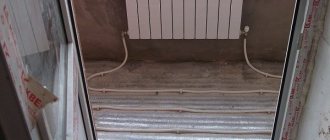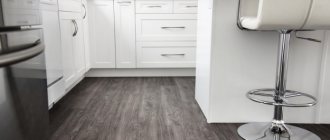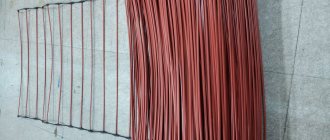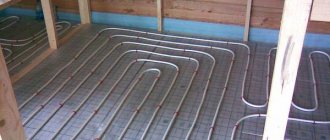Methods for laying film heated floors
As a rule, when laying heated floors with power supply, three methods of their location are used:
- Lay the flooring directly under the covering, as is the case with a film floor.
- Location in the thickness of the screed, on which, after it has dried, the finishing coating is laid.
- Installation of an electric heated floor over a tile screed.
If the floor screed is in perfect condition, you can install a heated floor under laminate or linoleum directly on it, which will significantly save time on additional work. When laying an electric cable floor in the kitchen, bathroom or loggia, the heating elements are hidden in the thickness of the screed, having previously laid a thermal insulating layer.
In the case of laying heated floors in two-story houses, where the floor insulation on the first floor has been completed, additional screed and thermal insulation are not necessary. Ceramic tiles laid on top and a thick layer of glue will serve as protection for the heated floor. True, you should first check the instructions for it.
Is it possible to put heated floors under laminate?
When deciding which heated floor is best for laminate, it should be taken into account that this material is vulnerable to moisture and sudden temperature changes. Then the question arises: is it possible to make heated floors under laminate? After all, not all laminate manufacturers produce panels that can be combined with heating elements. Having understood the basic parameters of laminated coatings and the operating conditions of heated floors, you can determine the heating system that is most suitable for laying this material.
Before buying laminate for heated floors, pay attention to the instructions for the material, which must indicate the possibility of such use. Markings with the recommended temperature limit can be seen on the packaging of the laminate. If you find it difficult to determine exactly where the information you need is listed, contact a consultant for help.
Warm laminate floors today are no longer something out of the ordinary, but quite commonplace.
Many modern manufacturers produce laminated panels that are adapted to install underfloor heating. In this case, the manufacturer indicates which type of underfloor heating is recommended for this product. Installing a heated floor under a laminate that is not designed for the use of this or that heating can lead to both failure of the system and damage to the laminated coating itself.
An innovation in the flooring market is laminate with built-in heating elements, thanks to which you can install a new beautiful floor immediately with heating. To install such a laminated coating, you must additionally purchase a transformer and accessories.
Laying laminate lamellas with a built-in heating system greatly simplifies the process of installing a heated floor. The covering is laid using special aluminum locks that securely and easily fix the boards together. In addition, the locks guarantee the safety of connections during operation. This flooring can be laid on any surface, including balconies and loggias.
The most modern and popular electric heating system today is underfloor heating.
Types and advantages of infrared film floors
Infrared film heated floors are becoming increasingly popular among buyers, since their radiation is not harmful to delicate wooden coverings such as laminate, parquet or parquet boards.
The following types of infrared film flooring are distinguished:
- Bimetallic
. It is a polyurethane film with a two-layer heating element built into it. Its top layer is made of copper alloy and additives, and the bottom layer is made of aluminum alloy with additives. - Carbon
. The two-layer Dacron film serves as a resistive component in which the heating elements are connected in series and parallel.
The latter is quite often used not only for insulating floors, but also walls. This material is easy and convenient to work with, since it is elastic and small in size (585x545 mm). Read also: “Infrared film for heated floors - operating principle and installation diagram.”
Let us name a number of undoubted advantages of infrared film flooring:
- speed and ease of installation - it will take about 2 hours before laying the heated floor under the laminate is completed;
- the height of the room will not decrease due to raising the floor level, because the thickness of the film is only 3 mm;
- film heated floors have a high level of reliability;
- there is no need for additional work on pouring the screed, since the film infrared heated floor can be laid directly under the laminate, linoleum or carpet (read: “How to lay an infrared heated floor under linoleum”);
- does not dry out the air in the room, so the air humidity does not change due to heating;
- has an antiallergic effect on the human body;
- uses energy economically - 20% less than other types of heated floors;
- can be dismantled and moved to a new place of residence;
- has the effect of air ionization.
What you need when installing film heated floors
The infrared floor kit includes a thermal film rolled into a roll, insulating material, contact clamps and wiring for them. Additionally, you need to purchase a temperature sensor and thermostat.
A number of additional materials will serve to increase the service life of the floor and improve its thermal qualities.
Required:
- Construction single or double sided tape.
- Polyethylene film.
- Material with heat-reflecting properties.
Requirements for the base under a warm film floor under a laminate
Before laying a heated floor under the laminate, you must carefully prepare the base for it. If you plan to install it over an old floor, it is important to make sure that it is suitable for further use, does not contain depressions or irregularities, and can withstand the load after laying the finished floor.
The base should be cleaned, check for level differences - their value should not exceed a film thickness of 3 mm. Any irregularities found must be eliminated and the surface thoroughly dried. After this, the film heated floor can be laid under the laminate.
When placing the film over the floor surface, it is worth remembering that heating the space under the furniture is impractical and harmful to the furniture. However, if you plan to rearrange the furniture soon, you can cover the entire space of the room with a warm floor.
When planning the installation of a heated floor, you need to calculate the power consumption required for a specific area of the room. These values increase in direct proportion. You can get the necessary advice to calculate the optimal power and operating efficiency of a heated floor when purchasing a film floor.
Infrared heated floor under laminate
You can buy heated floors for laminate by ordering products on the websites of manufacturing companies and on the Internet. Systems of all brands are available for sale. The price of infrared heated floors for laminate depends on the manufacturer, the size of the film coating and the configuration. Heated floors presented in Russia, certified by the IR Radiation Association, are popular.
Film flooring is a modern version of an electric floor.
The electric floor developed by the Korean company Heat Plus has proven itself well. This manufacturer specializes in the production of film infrared floors and is constantly improving and updating its equipment. Over the past few years, production has been carried out on unique machines. RexVa floor heating systems, presented, are focused on the production of individual orders of film flooring, taking into account an acceptable price for the consumer.
The table shows the approximate prices at which you can buy infrared heated floors for laminate:
| Company | Series | Cost of the set, rub. | |
| from | before | ||
| CALEO | Line | 1690 | 7050 |
| Grid | 1250 | 27800 | |
| Gold | 1480 | 29500 | |
| Platinum | 1750 | 30500 | |
| Q-TERM | 450 | 11900 | |
| Heat Plus | 650 | 17900 | |
| NanoThermal | 990 | 19900 | |
The minimum price of heated floors for laminate per m2 produced by RexVa and Heat Plus companies is from 850 rubles, Caleo infrared floors will cost a little more - from 1,500 rubles per 1 m2.
On a note! When purchasing products from one manufacturer or another, request a certificate for infrared heated floors for laminate flooring. Consumer reviews will also give an idea of the feasibility of using the chosen option.
Laying insulating materials
The next important step in the process of how to properly lay a heated floor under a laminate is laying insulating materials to prevent the heated floor from coming into contact with moisture.
Insulation can then be installed to increase the efficiency of the underfloor heating and reduce heat loss from downward heat flows.
Any rolled material laid with the metallized side up, the seams of which should be taped, will do.
Before laying a heated floor under the laminate, it is best to use foam insulation materials no thinner than 3 mm in thickness.
Both reflective and non-reflective insulating materials are equally suitable for laminate insulation, as long as the thickness standards are met. Mylar reflective film performs well, but foil material is not entirely suitable for infrared film flooring, so it is not advisable to install it.
Metallized tape will optimally cope with the task of sealing seams between insulation sheets.
Choosing a location and preparing for installation of a thermostat
A thermostat is used to control the temperature of the heated floor.
The main functions of the thermostat are:
- setting the desired temperature level;
- setting heating periods;
- turning the heated floor on and off within the established programs in automatic mode.
Before laying a heated floor under the laminate, you need to decide on the location of the thermostat, since it affects the layout of the film and the laying of the wiring. As a rule, it is located 20 cm from the floor level.
Next, you can start developing a scheme for laying an infrared film heated floor.
Rod floor
Infrared heating systems include rod mats. The carbon mixture is enclosed in a durable shell, in the rods. They are connected to each other in 10 cm increments. The mats are connected in parallel.
We recommend: How to install infrared heated floors?
If a dry installation method is used for thermal film, then a rod-based heated floor requires a screed or adhesive solution 1-2 cm deep. Both tiles and laminate can be laid on it. Carpet is not recommended. How can you assemble a warm floor under a laminate with your own hands?
- perform a screed or use a solution for a self-leveling floor;
- form waterproofing;
- lay insulation; in order not to increase the height of the floor, it is recommended to use insulation with a reflective surface; the foil layer will direct the IR rays upward;
- Next, the rod mats are mounted:
- heating elements are covered with a 1-2 cm screed;
- After the concrete solution has completely dried, the laminate can be laid.
A distance of 1 cm is maintained between the laid mats. The elements are reinforced with tape. When arranging a core floor, it is recommended to equip the interior with furniture on legs. The distance between the bottom surface of the cabinet and the floor should be 5 cm. The air space will prevent the system from overheating.
Method of laying heating elements
To know how to install a heated floor under a laminate, you should check the developed diagram when placing the film.
An infrared film heated floor may not cover the entire area of the room, which depends on its purpose and intensity of use (read: “How to lay an infrared heated floor under a laminate - installation instructions”).
The film can be laid:
- On half the total area of the room, if other heating sources are provided, and the heated floor serves as additional support. In this case, a power of 90-150 W/m2 is sufficient.
- For 70-80% of the total area, if it is the only heating device. The floor power in this case increases to 150 W/m2.
The distance from the edge of the film to the walls or furniture should be at least 20 cm, and to the heating devices - at least 1 meter. This is done to avoid overheating of the floor and its failure.
To position the film on the floor surface as conveniently and effectively as possible, it can be cut along the light marks. In this case, the maximum length of the strip cannot exceed 8 m.
Please note that laying pieces of film overlapping is strictly prohibited.
If the film is single-sided, it is placed with the reinforced side down, and if it is double-sided, the side does not matter. The direction of laying the film should be towards the thermostat to minimize wiring costs. The film should be laid with the copper contacts facing down, to which clamps for connecting the wiring are subsequently attached.
Cable heating
A heating system via cable or heating mats under laminate is rarely used, but there is no categorical prohibition on floor coverings. Before installing a “warm floor” under a laminate, it is necessary to study what characteristics the material and heating system have.
For heating, sections or mats with a single-core or two-core conductor are used. For rooms with large heat losses, sections with high power, more than 20 kW/m2, are laid. For well-insulated rooms, 15 kW/m2 systems are used.
It is recommended to choose mats with a protective coating. It is made from a polymer with the addition of aluminum. Mats are produced in rolls. The material is rolled out over the entire surface of the base. If it is necessary to rotate the mats, the mesh is cut, leaving the cable intact. Turn the tape and continue installing the heated floor.
In addition to heating mats, cable sections are used. They are a conductor of limited length and a certain power. The sections are laid on the floor in a snail or snake pattern, maintaining a certain step along the entire heated surface.
We recommend: What is included in a heated floor cake?
For installation, it is recommended to use a contour coating specifically for cable laying. The conductor in them is located in the gutters, which reduces the mechanical load on it. A single-core cable is connected to the electrical network at two ends. A two-core conductor is connected to the network at one end.
If the laminate is laid on a cable heated floor in a cold room, on a balcony or on a veranda, then the installation diagram will be as follows:
- clean, level base;
- polyethylene film;
- insulation 3-5 cm;
- cable or mats;
- polyethylene film;
- concrete screed 5 cm;
- laminate.
It is not practical to use electric heating of rooms in the form of underfloor heating cables. A high energy consumption will be required to heat the system and the deep concrete screed. It is most effective and economical to install laminate flooring on a heating system using infrared heating elements. Warm floors with cables or mats are best laid under tiles.
Slice isolation
Cut areas containing exposed copper require additional insulation. Often, bitumen insulation is used for these purposes. To cover bare areas on both sides, it is necessary to cut off large pieces of film.
Then holes are cut in the film, where the pasted copper areas are pressed in and the sections are covered with tape. You can begin to insulate the junctions of contacts with clamps and wiring only after they have been installed. To attach the clamp, it must be placed between the film and the copper strip, and then pressed with pliers.
Preparing the subfloor
Before installing the infrared heating system, the base of the floor is carefully prepared. First, it is leveled and primed; if there are cracks, they are repaired. Then the floor is cleared of debris and vacuumed. After this, the waterproofing film and the selected substrate are spread over the entire area of the room, and not just in the places where the heating elements are installed. The backing sheets are placed end-to-end, with the thermally reflective surface facing out. They are connected to each other with special tape and fixed to the floor.
Laying and checking the wiring
Connecting wires
Laying the wiring of the film heated floor must be done from the center to the baseboards on the walls to avoid excessive pressure from the floor covering. The wires are laid under the film, in which holes for them are pre-cut. After fixing, the incision sites are secured with tape. The wiring layout must be made so as not to protrude beyond the heat-insulating substrate.
The cable is connected to the terminals using the parallel method. The ends of the wires are stripped, pushed through a cut in the film and inserted into the clamp attachment points, after which they are pressed with pliers. The junction is isolated and fixed to the film with tape. In order not to confuse the wiring lines, you can choose cables of two colors.
Thermostat connection
After laying the thermal film, you need to attach a temperature sensor to it. It is usually located in the area of the second section. Cuts are made in the film for its wiring and the sensor itself. In addition, it is worth making sure that the film makes a smooth turn where the cable passes under the temperature sensor. This will prevent the cable from breaking.
Once the sensor is installed, you can begin installing the thermostat. It is preferable when it is connected permanently, however, connection through a socket is also allowed.
You can keep the wiring in working condition for a long time if most of it is laid under the baseboard.
The thermostat should be connected to the film infrared heated floor in the same way as other types of heated floors. Two wires each, suitable for the temperature sensor and the heated floor, are connected in pairs on both sides of the thermostat. The two remaining free connectors are used to connect power cables. Grounding is connected using a terminal.
System check
Before installing laminate flooring, you should make sure that the heated floor is functioning correctly. If there is no overheating of individual elements or sparking, then the thermal film is of high quality.
As soon as it is established that there are no malfunctions, the heating elements should be covered with a layer of protective polyethylene, no thicker than 80 microns, designed to prevent moisture from entering the thermal film. In addition, such a layer will increase the service life of the heated floor. Lay polyethylene film overlapping over the entire surface of the heated floor.
Water heating
In country houses that do not have central heating, liquid underfloor heating is installed. The system is a pipeline of pipes in which coolant circulates. The liquid used is water, antifreeze, and propylene glycol. Pipes can be laid in a screed or using a dry installation method. Laying a heated floor under a laminate using a dry method will help avoid the formation of condensation on the substrate and cladding.
The installation diagram is as follows:
- a circuit for the liquid line is installed on the rough surface; To do this, you can purchase insulation with a shaped surface with outlets for pipes;
- the base must be insulated from moisture and cold;
- a foil layer and reinforced mesh are laid on the insulation: it is easier to attach pipes to it;
- cover the contour with plywood, gypsum fiber board or fiberboard;
- perform floor covering: lay the underlay and finishing coating.
If a screed was used during installation, then it is necessary to lay polyethylene on it, which will prevent moisture from entering the substrate and wooden covering: the cladding will last longer. The main water system can be built under carpet or linoleum. Laying laminate flooring on a heated floor is done only after the concrete solution has completely dried.
We recommend: How is the length of a heated floor pipe calculated?
For a heated floor system, it is recommended to purchase special lamellas. The heating system can be anything, but its design will differ in insulation materials. They are designed to reduce the impact of moisture and high temperature on the floor covering. Infrared heating systems are most preferable for laminate flooring.
YouTube responded with an error: The request cannot be completed because you have exceeded your quota.
- Related Posts
- How to install a heated floor under a cork?
- Which is better, warm floors or radiators?
- How does a comb for heated floors work?
- How to install heated flooring in a garage?
- How to repair a heated floor?
- How is polystyrene foam used for heated floors?
Laminate installation
For installation on heated floors, you should use a laminate with special markings, and during installation it is useful to be careful not to damage the thermal film. Read also: “Which laminate is better for a heated floor - choosing the optimal material.”
Assembling laminate flooring is quite simple. Each of the panels is equipped with a locking mechanism, so all you have to do is position them at an angle and connect them, then lower the panel until it clicks. If small gaps form, you can tap the panels with a rubber hammer. First, the panels are fastened together with narrow edges, and then the strips are connected to each other.
When laying laminate flooring, it is important to leave gaps near the walls to allow the coating to expand with temperature changes. Upon completion of this process, baseboards are installed around the perimeter of the room, into which the heated floor wiring is hidden.
The heating film must be given time to warm up to room temperature, after which it can be turned on.
